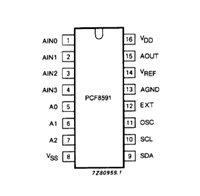LNK454/456-458/460
LinkSwitch-PL Application Example
The circuit shown in Figure 7 provides a single constant current
output of 350 mA with an LED string voltage of 15 V. The
output current can be reduced using a standard AC mains
TRIAC dimmer down to 1% (3 mA) without instability and
flickering of the LED load. The board is compatible with both
low cost leading edge and more sophisticated trailing edge
dimmers.
Due to the much lower power consumed by LED lighting
compared to incandescent lighting, the current drawn by the
lamp is below the holding current of the TRIAC dimmer. This
causes undesirable behavior such as limited dimming range
and/or flickering. Inrush current that flows to charge the input
capacitance when the TRIAC turns on causes current ringing.
This too can cause similar undesirable behavior as the ringing
may cause the TRIAC current to fall to zero and turn off for the
remainder of the AC cycle or rapidly turn on and off.
The board was optimized to operate over the universal AC input
voltage range (85 VAC to 265 VAC, 47 Hz to 63 Hz) but suffers
no damage over an input range of 0 VAC to 300 VAC. This
increases field reliability and lifetime during line sags and swells.
LinkSwitch-PL based designs provide high power factor (>0.9
at 115 VAC / 230 VAC) and low THD (<15% at 230 VAC, <10%
at 115 VAC) enabling compliance to all current international
requirements and enabling a single design to be used
worldwide.
To overcome these issues the design includes three circuit
blocks, a passive damper, an active damper and a bleeder. The
drawback of these blocks is increased power dissipation and
therefore reduced efficiency of the supply. In this design, the
values selected allow flicker-free operation with a single lamp
connected to a single dimmer at high-line. For flicker-free
operation with multiple lamps in parallel or at low line voltages
only (100/115 VAC) then the values may be optimized to reduce
dissipation and increase efficiency.
The form factor of the board was chosen to meet the requirements
for standard pear shaped (A19) LED replacement lamps. The
output is non-isolated and requires the mechanical design of
the enclosure to isolate both the supply and the LED load from
the user.
As these blocks are only required for dimming applications, for
non-dimming designs these components can simply be omitted
with jumpers used to replace R7, R8 and R20.
PI Part Selection
Active and Passive Damper Circuits
One device size larger than required was selected to increase
efficiency and reduce device thermal rise. This typically gives
the highest efficiency. Further increasing the device size often
results in the same or lower efficiency due to the larger
switching losses associated with a larger power MOSFET.
Resistor R20 forms a passive damper that together with the
active damper limits the peak inrush current when the TRIAC
fires on each half-cycle. It should be a flameproof type to safely
fail during a single point fault (e.g. failure of a bridge diode).
The active damper circuit connects a series resistance (R7 and
R8) with the input rectifier for a period of each AC half-cycle, it is
then bypassed for the remainder of the AC cycle by a parallel
SCR (Q3). Resistor R3, R4 and C3 determines the delay before
the turn-on of Q3 which then shorts out the damper resistors
AC Line TRIAC Dimmer Interface Circuits
The requirement to provide output dimming with low cost,
TRIAC based, leading edge phase dimmers introduces a
number of trade-offs in the design.
R7 and R8.
C10
R17
27 Ω
1 nF
100 V
R9
4.7 kΩ
Active Damper
Bleeder
15 V, 350 mA
1
2
7
3
6
L2
2.2 mH
C7
1000 pF
630 V
D5
SS110-TP
R12
100 kΩ
C11
680 µF
25 V
R3
750 kΩ
R10
510 Ω
R13
4.7 Ω
T1
EE16
RTN
R18
0.82 Ω
1%
BR1
D2
US1J
MB6S
600 V
F1
3.15 A
L
D4
BAV19WS
R15
3.3 kΩ
C4
22 nF
630 V
C5
68 nF
400 V
C6
68 nF
400 V
R4
750 kΩ
D6
DL4006
RV1
275 VAC
90 - 265
VAC
R2
4.7 kΩ
VR2
MAZS2000ML
20 V
LinkSwitch-PL
U1
LNK457DG
D
L1
2.2 mH
N
R20
CONTROL
BP
R21
1 kΩ
R14
1 kΩ
47 Ω
Passive Damper
R11
510 Ω
FB
S
C3
22 nF
50 V
Q3
C8
10 nF
50 V
C9
1 µF
25 V
R16
10 kΩ
R7
240 Ω
R8
240 Ω
PI-6171a-102910
Figure 7. Schematic of a 5 W, 15 V LED Driver for A19 Incandescent Lamp Replacement.
6
Rev. C 10/11
www.powerint.com






 STM32F030C6芯片介绍:主要参数分析、引脚配置说明、功耗及封装
STM32F030C6芯片介绍:主要参数分析、引脚配置说明、功耗及封装

 PCF8591数据手册解读:参数、引脚说明
PCF8591数据手册解读:参数、引脚说明

 一文带你了解ss8050参数、引脚配置、应用指南
一文带你了解ss8050参数、引脚配置、应用指南

 深入解析AD7606高性能多通道模数转换器:资料手册参数分析
深入解析AD7606高性能多通道模数转换器:资料手册参数分析
